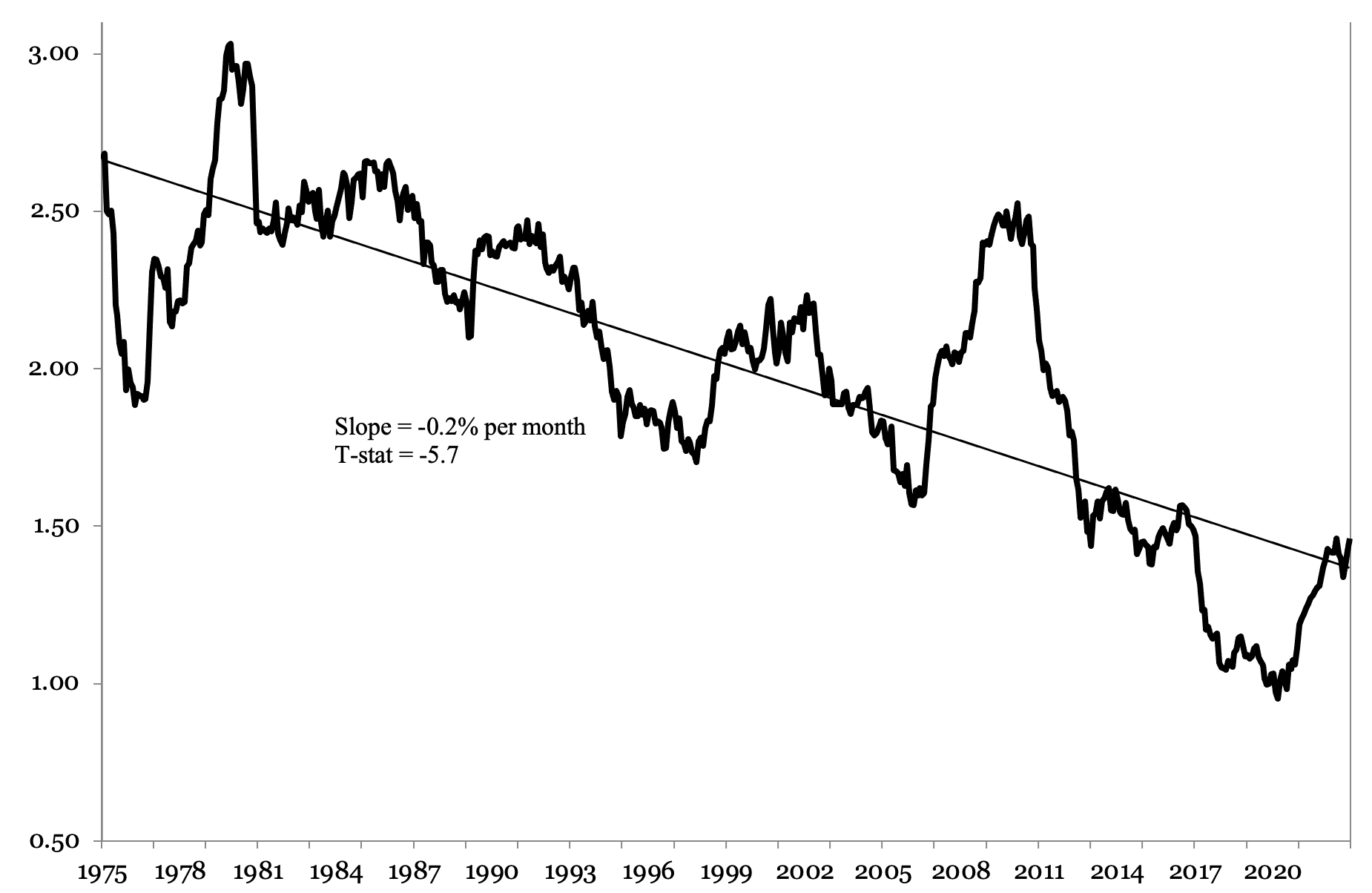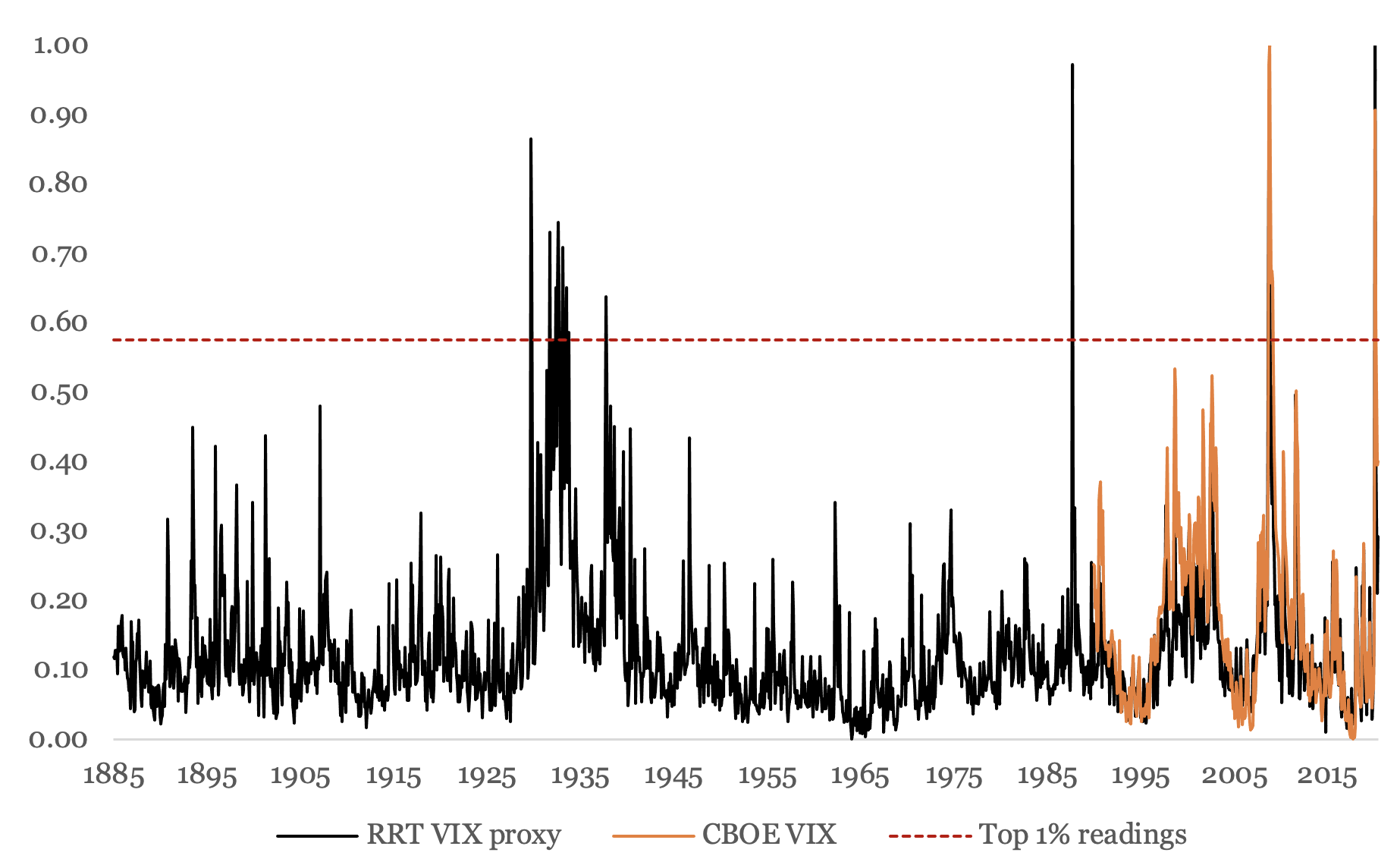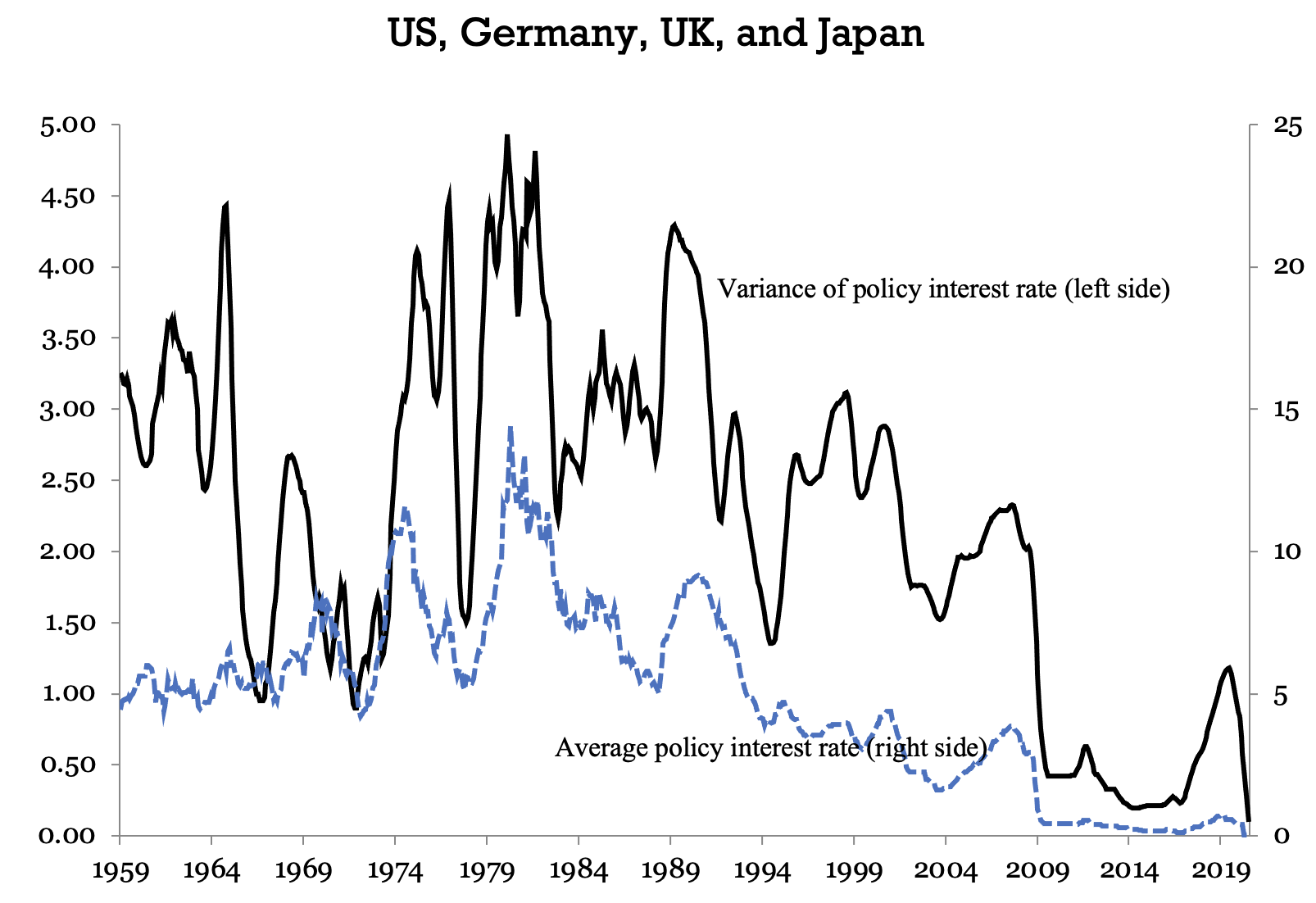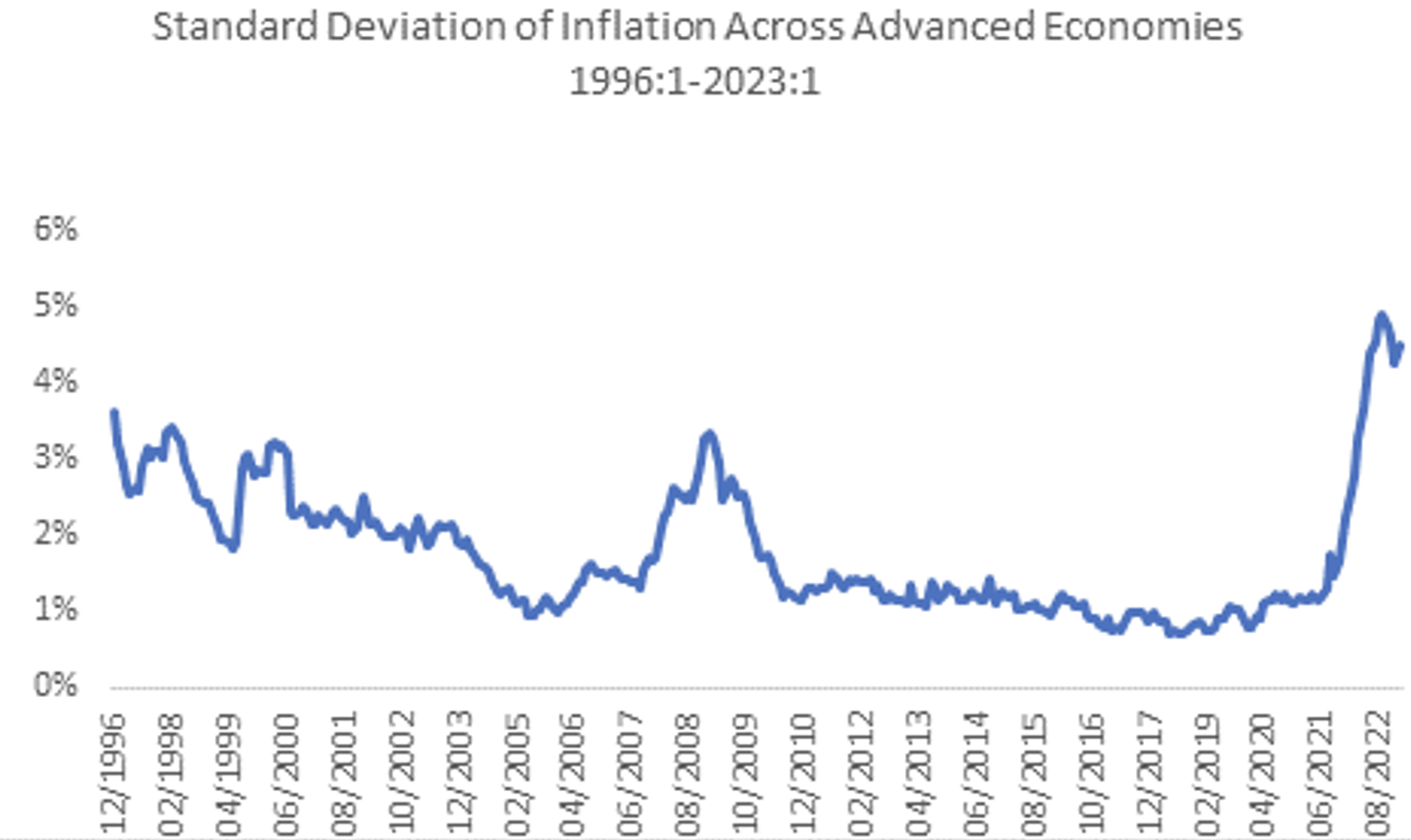The global economy has witnessed great economic volatility in the first two decades of the 21st century, reflected in a pandemic, two major global recessions, wild gyrations in asset prices, and disruptions to international trade. It may therefore surprise readers that this era has also been a period of unusually stable exchange rates; that is, until the past year. Exchange rates are notoriously disconnected from economic fundamentals and difficult to forecast (Meese and Rogoff 1983, see Itshoki and Mukhin 2021 for a recent overview). Nevertheless, the absence of sharp exchange rate movements in the face of economic and financial volatility, like Arthur Conan Doyle’s dog that didn’t bark, may shed light on the potential causes of exchange rate volatility.
Figure 1, an update from Ilzetzki et al. (2020), shows the volatility of the US dollar-euro and the US dollar-Japanese yen spot rates from the end of Bretton Woods era of fixed exchange rates to the end of 2022. Volatility is measured as the absolute value of the monthly percent change in the exchange rate and the figure shows four-year moving averages. There is a clear downward trend and average monthly exchange rate movements are now roughly half the size of those in the 1970s and early 1980s.
Figure 1 Monthly absolute value, % change in spot rate
(4-year moving average; top: USD-EUR; bottom: USD-JPY)
Source: IMF IFS, Ilzetzki et al. (2020), and the authors.
Particularly puzzling is the missing volatility during Covid-19. Exchange rate volatility rises in US recessions, as the figure lays bare. But exchange rate volatility was at historical lows during the Covid-19 recession, the deepest recession on record (see Marin and Corsetti 2020 for an analysis on how the US dollar exchange rate against other currencies during Covid-19 compared to other crises). In contrast to the exchange rates in high-income countries, volatility was greatly elevated in most other asset prices (including the exchange rates of some emerging markets). For example, March and April 2020 were among the most volatile months in the history of stock markets, as shown in Figure 2.
With economies locked down and financial markets going from bust to boom, how did exchange rates remain so stable? In his influential 1976 article, Rudiger Dornbusch posited monetary policy as a major driver of exchange rate volatility. Since Dornbusch (1976), researchers have put far greater emphasis on real (Backus Smith 1993) and financial (Gabaix and Maggiori 2015) factors. Zhang and Liao (2020) view currency hedging as an important determinant of exchange rate fluctuations. But the Covid-19 pandemic presented a natural experiment of sorts with enormous real and financial volatility, but nearly comatose interest rate policy. Only monetary policy fits the bill to explain the uncanny exchange rate stability in 2020-2021. Policy interest rates were at the effective zero lower bound in all major economies during this period and interest rate differentials were at all-time lows, as seen in Figure 3.
Figure 2 Implied volatility, VIX and imputed VIX
Source: Ilzetzki et al. (2020).
Figure 3 Average and standard deviation rate: US, Germany, UK, and Japan
Source: Ilzetzki et al. (2020).
Not only short-term, but also long-term interest rate differentials flattened, in part as major central banks also resorted to quantitative easing – large-scale asset purchases (see Dedola et al. 2020 for a study on the effects of quantitative easing by the Fed and ECB on the USD/EUR exchange rate). The extreme of which was the Bank of Japan putting a ceiling on the ten-year government yield. Yields on longer-term German and Japanese bonds also hit zero in 2014 and remained at historical lows during the pandemic. Indeed, our analysis in Ilzetzki et al. (2020) identifies a breakpoint in exchange rate volatility precisely in 2014, with volatility sharply decreasing that year, even relative to its declining 40-year trend. Recent events appear to support Dornbusch’s hypothesis that monetary policy is a main driver of exchange rate volatility.
In our article, we warned that “some notable differences between the current pandemic recession and the 2008 financial crisis suggest a distinct chance that the inflation, interest and exchange rate aftermath will eventually become much more volatile, even if markets presently heavily discount the possibility”. Developments in 2022 showed that these concerns weren’t moot. Inflation has indeed reared its head globally at rates not seen since the early 1980s. Higher inflation has also been associated with larger inflation differences across countries as seen in Figure 4. While initially tardy in reading, the Fed, ECB, and other major central banks have begun tightening policy and not in perfect sync. Figure 1 shows that this was accompanied by a revival of exchange rate volatility, further reinforcing the importance of monetary policy in affecting exchange rate volatility.
Figure 4 Standard deviation of inflation across advanced economies
The zero lower bound years following the 2008 global financial crisis have constituted an important natural experiment for models of exchange rate determination. As investors came to anticipate that the zero lower bound on policy rates would remain binding for a long time to come, long-term interest rates correspondingly adjusted downwards. This episode provided an important glimpse into how other factors, particularly portfolio considerations, can influence exchange rates. But the episode also made clear just how important interest rate volatility, at all horizons, is for exchange rates. Only when interest rate policy started to become much more uncertain over the past 15-18 months has more normal exchange rate volatility returned, albeit not at the level of the 1970s and 1980s (Sussman and Saadon 2018 indeed argue that exchange rates are anchored by the monetary regime and short-term interest rates). Still, during 2022, the yen depreciated against the dollar by roughly 30%, the euro fell below parity, and the UK pound nearly did as well. If the analysis of our 2020 Brookings paper is correct, then major currency exchange rate volatility is likely to remain elevated until the next ultra-low interest rate period arrives, which may not be anytime soon.
References
Backus, D K and G W Smith (1993), “Consumption and Real Exchange Rates in Dynamic Economies with Non-traded Goods”, Journal of International Economics 35(3/4): 297–316.
Dedola, L, G Georgiadis, J Gräb, and A Mehl (2020), “Does a Big Bazooka Matter? Quantitative Easing Policies and Exchange Rates”, VoxEU.org, 17 January.
Dornbusch, R (1976), “Expectations and Exchange Rate Dynamics”, Journal of Political Economy 84(6): 1161–76.
Gabaix, X and M Maggiori (2015), “International Liquidity and Exchange Rate Dynamics,” The Quarterly Journal of Economics 130(3): 1369–1420
Ilzetzki, E, C M Reinhart, and K S Rogoff (2020), “Will the Secular Decline in Exchange Rate and Inflation Volatility Survive Covid-19?”, Brookings Papers on Economic Activity, Fall.
Itshoki, O and D Mukhin (2021), “Exchange Rate Disconnect in General Equilibrium,” Journal of Political Economy 129(8).
Marin, E and G Corsetti (2020), “The dollar and international capital flows in the COVID-19 crisis”, VoxEU.org, 3 April.
Meese, R and K Rogoff (1983), “Empirical Exchange Rate Models of the Seventies: Do They Fit Out of Sample?”, Journal of International Economics 14(1): 3–24.
Sussman, N and Y Saadon (2018), “Nominal exchange rate dynamics and monetary policy: Uncovered interest rate parity and purchasing power parity revisited”, VoxEU.org, 31 October.
Zhang, T and G Liao (2020), “Currency hedging, exchange rate movement, and dollar swap line usage during Covid-19 pandemic”, VoxEU.org, 1 October.










